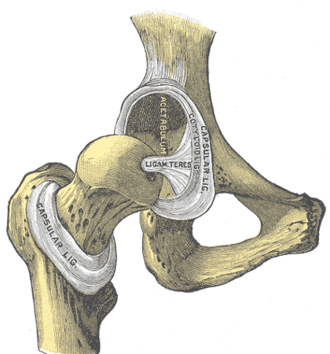Ortolani test
Ortolani Test is a medical procedure used in the early detection of Developmental Dysplasia of the Hip (DDH) in infants. The test is named after Marino Ortolani, an Italian pediatrician who first described it in 1937. It is a critical examination for newborns and infants to prevent future hip dysplasia, which can lead to hip dislocation and osteoarthritis in the long term if left untreated.
Procedure
The Ortolani Test is performed by a trained healthcare professional, usually during a newborn's first health examination and at subsequent well-baby visits. The infant is placed in a supine position (lying on the back). The examiner holds the baby's legs in a flexed position, with the knees bent and the thighs spread apart. Gentle pressure is then applied to move the thighs outward and upward. A positive Ortolani Test is indicated by a distinctive "clunk" sound or sensation, which suggests that the femoral head is moving back into the acetabulum, indicating potential DDH.
Significance
Early detection of DDH through the Ortolani Test is crucial for effective treatment. If diagnosed early, DDH can often be corrected using non-surgical methods such as a Pavlik harness, which helps to keep the hip in the correct position as it develops. Delayed diagnosis or treatment, on the other hand, may require more invasive procedures, including surgery, and can lead to long-term complications such as limp, hip pain, or hip osteoarthritis.
Limitations
While the Ortolani Test is a valuable tool for detecting DDH, it has its limitations. The sensitivity of the test decreases as the child ages, particularly after the age of 3 months, as the ligaments of the hip joint become tighter and the dislocated hip may become more difficult to reduce. Additionally, the test requires significant expertise to perform accurately, and there is a risk of false positives or negatives.
Complementary Tests
The Ortolani Test is often performed in conjunction with the Barlow Test, another examination for DDH. The Barlow Test checks for the possibility of dislocating a hip that is in its normal position, whereas the Ortolani Test checks for the ease of returning a dislocated hip to its normal position. Together, these tests provide a comprehensive assessment of hip stability in infants.
Conclusion
The Ortolani Test remains a fundamental part of neonatal orthopedic examination, essential for the early detection and treatment of DDH. Its effectiveness, however, is highly dependent on the skill and experience of the healthcare provider performing the test. Early diagnosis and treatment are key to preventing the long-term complications associated with untreated DDH.
| Musculoskeletal examination | ||||||||||||||||||||||||||
|---|---|---|---|---|---|---|---|---|---|---|---|---|---|---|---|---|---|---|---|---|---|---|---|---|---|---|
|
Pediatric glossary of terms | Glossary of medical terms | Dictionary of pediatrics
This article is a medical sign stub. You can help WikiMD by expanding it!
Transform your life with W8MD's budget GLP-1 injections from $125.
W8MD offers a medical weight loss program to lose weight in Philadelphia. Our physician-supervised medical weight loss provides:
- Most insurances accepted or discounted self-pay rates. We will obtain insurance prior authorizations if needed.
- Generic GLP1 weight loss injections from $125 for the starting dose.
- Also offer prescription weight loss medications including Phentermine, Qsymia, Diethylpropion, Contrave etc.
NYC weight loss doctor appointments
Start your NYC weight loss journey today at our NYC medical weight loss and Philadelphia medical weight loss clinics.
- Call 718-946-5500 to lose weight in NYC or for medical weight loss in Philadelphia 215-676-2334.
- Tags:NYC medical weight loss, Philadelphia lose weight Zepbound NYC, Budget GLP1 weight loss injections, Wegovy Philadelphia, Wegovy NYC, Philadelphia medical weight loss, Brookly weight loss and Wegovy NYC
|
WikiMD's Wellness Encyclopedia |
| Let Food Be Thy Medicine Medicine Thy Food - Hippocrates |
Medical Disclaimer: WikiMD is not a substitute for professional medical advice. The information on WikiMD is provided as an information resource only, may be incorrect, outdated or misleading, and is not to be used or relied on for any diagnostic or treatment purposes. Please consult your health care provider before making any healthcare decisions or for guidance about a specific medical condition. WikiMD expressly disclaims responsibility, and shall have no liability, for any damages, loss, injury, or liability whatsoever suffered as a result of your reliance on the information contained in this site. By visiting this site you agree to the foregoing terms and conditions, which may from time to time be changed or supplemented by WikiMD. If you do not agree to the foregoing terms and conditions, you should not enter or use this site. See full disclaimer.
Credits:Most images are courtesy of Wikimedia commons, and templates, categories Wikipedia, licensed under CC BY SA or similar.
Translate this page: - East Asian
中文,
日本,
한국어,
South Asian
हिन्दी,
தமிழ்,
తెలుగు,
Urdu,
ಕನ್ನಡ,
Southeast Asian
Indonesian,
Vietnamese,
Thai,
မြန်မာဘာသာ,
বাংলা
European
español,
Deutsch,
français,
Greek,
português do Brasil,
polski,
română,
русский,
Nederlands,
norsk,
svenska,
suomi,
Italian
Middle Eastern & African
عربى,
Turkish,
Persian,
Hebrew,
Afrikaans,
isiZulu,
Kiswahili,
Other
Bulgarian,
Hungarian,
Czech,
Swedish,
മലയാളം,
मराठी,
ਪੰਜਾਬੀ,
ગુજરાતી,
Portuguese,
Ukrainian
Contributors: Prab R. Tumpati, MD


